
When it comes to cleaning, there are numerous products on the market that promise to make our lives easier. However, one product that is often overlooked is WD-40. While it is typically known for its ability to lubricate and prevent rust, WD-40 can also be a game-changer in your cleaning routine.
Here, we will explore 14 different ways in which you can use WD-40 to tackle common cleaning tasks around your home. From removing stubborn stains to revitalizing old furniture, this versatile product can truly revolutionize the way you clean.
One of the most impressive uses of WD-40 is its ability to remove grease and grime. Whether it’s on your kitchen appliances or your car engine, a simple application of WD-40 and a quick wipe with a cloth can easily cut through the toughest of messes. Additionally, WD-40 can help to prevent future build-up, saving you time and effort in the long run.
Another surprising use for WD-40 is in removing adhesive residue. Whether it’s a sticker on your laptop or sticky residue left behind by tape, spraying WD-40 onto the affected area and allowing it to sit for a few minutes can make the removal process a breeze.
In conclusion, WD-40 is not just a lubricant or rust-preventer. With its wide range of cleaning applications, it has the potential to revolutionize your cleaning routine. So why not give it a try and see the difference it can make in your home?
Discover the Benefits of WD-40 for Your Cleaning Routine
1. Remove Sticker Residue
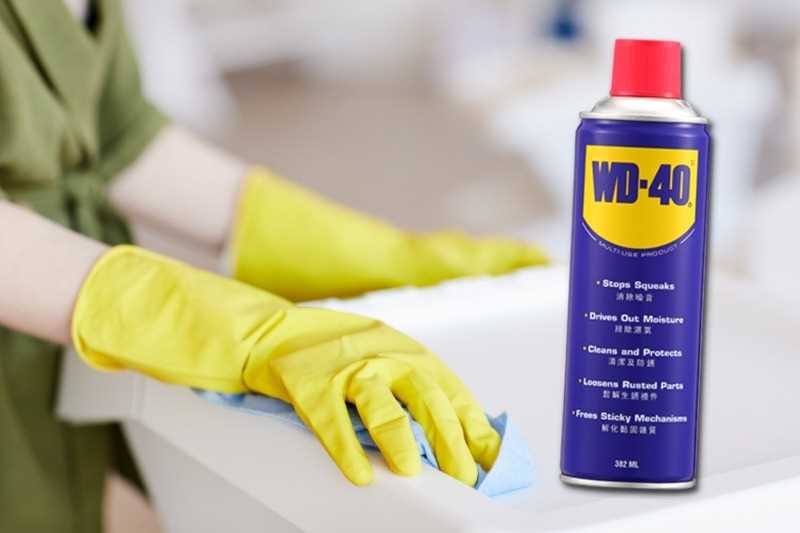
WD-40 can effectively remove sticky residue from surfaces. Simply spray a small amount onto the residue and let it sit for a few minutes. Then, wipe it away with a clean cloth.
2. Clean Stainless Steel Appliances
WD-40 can help keep your stainless steel appliances looking shiny and clean. Spray a small amount onto a clean cloth and wipe down the surface of the appliance. This will help remove fingerprints, smudges, and other marks.
3. Remove Water Stains
If you have water stains on your bathroom fixtures or kitchen sink, WD-40 can help remove them. Spray a small amount onto the affected area and scrub with a sponge or cloth. Rinse with water afterwards.
4. Polish Chrome Surfaces
If you want to make your chrome surfaces sparkle, try using WD-40. Spray a small amount onto a clean cloth and buff the chrome until it shines.
5. Unclog and Deodorize Drains
WD-40 can be used to help unclog and deodorize drains. Spray a small amount into the drain, let it sit for a few minutes, and then rinse with hot water. This can help remove grease and grime, as well as eliminate unpleasant odors.
6. Remove Crayon Marks
If your little ones have left crayon marks on your walls or furniture, WD-40 can help remove them. Spray a small amount onto the crayon marks and let it sit for a few minutes. Then, wipe away the marks with a clean cloth.
7. Clean Soap Scum
WD-40 can effectively clean soap scum from shower doors, tiles, and bathtubs. Spray a small amount onto the affected areas and let it sit for a few minutes. Then, scrub the area with a sponge or brush and rinse with water.
8. Remove Rust
If you have rusty tools or metal surfaces, WD-40 can help remove the rust. Spray a small amount onto the rusted area and let it sit for a few minutes. Then, scrub the area with a wire brush or scrub pad until the rust is gone.
9. Loosen Stuck Zippers
If you have a zipper that’s stuck, WD-40 can help loosen it. Spray a small amount onto the zipper and gently pull it up and down until it moves freely.
10. Clean Tile Grout
Tough stains on tile grout can be difficult to remove, but WD-40 can make the job easier. Spray a small amount onto the grout and let it sit for a few minutes. Then, scrub the grout with a toothbrush or grout brush and rinse with water.
11. Remove Ink Stains
If you have an ink stain on your clothing or upholstery, WD-40 can help remove it. Spray a small amount onto the stain and blot it with a clean cloth. Repeat this process until the stain is gone, then wash or clean as usual.
12. Remove Carpet Stains
WD-40 can also be used to remove tough stains from carpets. Spray a small amount onto the stain and let it sit for a few minutes. Blot the stain with a clean cloth until it’s lifted, then clean the area with carpet cleaner or soap and water.
13. Clean Sticky Residue from Scissors
WD-40 can help remove sticky residue from scissors, making them easier to use. Spray a small amount onto a clean cloth and wipe the blades of the scissors until the residue is gone.
14. Lubricate Door Hinges
If you have squeaky door hinges, WD-40 can help silence them. Spray a small amount onto the hinges and move the door back and forth to distribute the lubricant.
With its versatile cleaning capabilities, WD-40 is a must-have product for your cleaning routine. From removing stubborn stains to lubricating hinges, WD-40 can tackle a wide range of cleaning tasks.
Remove Stubborn Stains Effortlessly
When it comes to removing stubborn stains, WD-40 can be your secret weapon. Whether it’s oil, grease, crayon marks, or even adhesive residue, WD-40 can make the task a breeze.
1. Oil and grease stains
WD-40 is highly effective at breaking down oil and grease stains on various surfaces. Simply spray some WD-40 onto the stained area, let it sit for a few minutes, and then wipe it clean with a cloth or sponge.
2. Crayon marks
If your little Picasso accidentally left their artwork on the walls, don’t panic. WD-40 can help you remove crayon marks effortlessly. Spray some WD-40 on the marks, let it sit for a minute, and then wipe it clean with a cloth or paper towel.
3. Adhesive residue
Removing adhesive residue from surfaces can be a hassle, but not when you have WD-40. Spray a bit of WD-40 on the residue, let it sit for a few minutes, and then use a cloth or sponge to wipe it away.
4. Rust stains
If you have rust stains on your bathroom fixtures or tools, WD-40 can help you get rid of them. Spray some WD-40 on the stained area, then scrub it gently with a cloth or sponge. Rinse with water, and the rust stains should be gone.
5. Wine and food stains
Accidental spills happen, but with WD-40, they don’t have to leave a permanent mark. Spray a small amount of WD-40 on the stained fabric, let it sit for a few minutes, and then wash it as usual. The stain should disappear!
With WD-40, stubborn stains are no longer a challenge. Keep a can of this versatile product in your cleaning arsenal, and you’ll be amazed at how easily you can tackle even the toughest stains.
Restore the Shine to Your Stainless Steel Appliances
Stainless steel appliances can add a sleek and modern touch to any kitchen. However, over time, they can become dull and lose their shine. Luckily, WD-40 can help restore the shine to your stainless steel appliances. Here are some tips on how to use WD-40 to bring back the luster:
- Clean the surface: Before you can restore the shine, it’s important to clean the surface of the stainless steel appliance. Use a mild dish soap and warm water to remove any dirt or grime. Dry the surface thoroughly.
- Apply WD-40: Spray a small amount of WD-40 onto a soft cloth or paper towel. Gently rub the WD-40 onto the surface of the stainless steel in a circular motion.
- Remove excess WD-40: After applying WD-40, use a clean cloth or paper towel to remove any excess product from the stainless steel.
- Buff the surface: To restore the shine, use a clean, dry cloth to buff the surface of the stainless steel. Apply light pressure and continue buffing until the desired shine is achieved.
Remember to always test WD-40 on a small, inconspicuous area of the stainless steel appliance before applying it to the entire surface. If any damage or discoloration occurs, discontinue use immediately.
Using WD-40 to restore the shine to your stainless steel appliances is a quick and affordable solution. With a little bit of effort, you can bring back the luster and make your kitchen look brand new again.
Say Goodbye to Rust and Corrosion
If you’ve ever dealt with rust and corrosion, you know how frustrating it can be. Not only does it make your tools and metal items look unsightly, but it can also weaken them and shorten their lifespan. Luckily, WD-40 can help you say goodbye to rust and corrosion with its powerful anti-rust properties.
Here are some ways you can use WD-40 to combat rust and corrosion:
- Prevent rust on metal tools: Apply a thin coat of WD-40 to your metal tools to keep them rust-free. The oil-based formula acts as a barrier between the metal and moisture, preventing rust from forming.
- Remove rust from metal surfaces: If you already have rust on your metal surfaces, WD-40 can help remove it. Spray the affected area with WD-40 and let it sit for a few minutes. Then, scrub the rust away with a brush or sponge.
- Protect outdoor furniture: Outdoor furniture is often exposed to the elements, making it prone to rust and corrosion. To protect your outdoor furniture, spray WD-40 on metal parts to create a protective layer.
- Loosen rusted bolts and nuts: WD-40 is well-known for its ability to loosen rusted bolts and nuts. Simply spray WD-40 on the rusty area and let it penetrate for a few minutes. Then, use a wrench or pliers to loosen the bolt or nut.
- Remove rust from bicycle chains: Over time, bicycle chains can develop rust, which can affect their performance. Apply WD-40 to the rusty areas of the chain and let it sit for a few minutes. Then, use a brush or cloth to remove the rust.
By using WD-40, you can easily say goodbye to rust and corrosion and keep your metal items in top condition for longer.
Easily Clean and Lubricate Your Tools
If you have a collection of tools, whether it’s for DIY projects or professional use, you know how important it is to keep them clean and well-maintained. WD-40 can be a game-changer when it comes to cleaning and lubricating your tools. Here are some ways you can use WD-40 to easily clean and lubricate your tools:
1. Remove rust
Tools can easily develop rust, especially if they are exposed to moisture. WD-40 can help remove rust from your tools. Simply spray WD-40 on the rusty area and let it sit for a few minutes. Then, use a wire brush or a cloth to scrub off the rust. Wipe the tool clean with a dry cloth.
2. Loosen stuck parts
If you have tools with stuck or jammed parts, WD-40 can help loosen them up. Spray WD-40 on the stuck parts and let it penetrate for a few minutes. Then, try moving the parts gently to loosen them. This works well for tools like wrenches, pliers, and clamps.
3. Remove adhesive residue
Tools often get covered in adhesive residue, whether it’s from stickers or tape. WD-40 can effectively remove adhesive residue from your tools. Spray WD-40 on the residue, let it sit for a few minutes, and then use a cloth to wipe it off. Repeat if necessary.
4. Clean cutting tools
Cutting tools like saws, shears, and scissors can become dirty and sticky over time. WD-40 can help clean and lubricate these tools. Spray WD-40 on the blades and cutting surfaces, then wipe them clean with a cloth. This will remove any built-up residue and ensure smooth cutting.
5. Protect against rust

After cleaning your tools, it’s important to protect them against future rusting. Spray a light coating of WD-40 on the metal parts of your tools and wipe off any excess. This will create a protective barrier that helps prevent rust from forming.
6. Lubricate moving parts
If you have tools with moving parts, such as hinges or joints, WD-40 can act as a lubricant. Spray WD-40 on the moving parts and work them back and forth to distribute the lubricant. This will help keep your tools operating smoothly.
7. Clean and lubricate hand tools
Hand tools like screwdrivers, wrenches, and pliers can benefit from regular cleaning and lubrication. Spray WD-40 on a cloth and wipe down the handles and metal parts of your hand tools. This will remove dirt and grime and provide lubrication for smooth operation.
8. Remove sticky residue from tape measures
If your tape measures have sticky residue from old tape, spray WD-40 on the residue and let it sit for a few minutes. Then, use a cloth to wipe it off. This will help keep your tape measure clean and working properly.
9. Clean and protect garden tools
Garden tools, such as shovels, rakes, and pruners, can benefit from WD-40’s cleaning and protective properties. Spray WD-40 on the blades and metal parts of your garden tools, then wipe them clean with a cloth. This will help prevent rust and keep the tools functioning properly.
10. Clean and lubricate power tools
Power tools, like drills and saws, can also benefit from WD-40. Spray WD-40 on a cloth and wipe down the surfaces of your power tools to remove dirt and grime. You can also spray WD-40 on the moving parts to lubricate them and ensure smooth operation.
11. Extend the life of battery terminals
If you have tools that use batteries, it’s important to keep the battery terminals clean and free from corrosion. Spray WD-40 on a cloth and wipe down the battery terminals to remove any dirt or corrosion. This will help prolong the life of your batteries and ensure proper functioning of your tools.
12. Clean and lubricate locks
If you have tools with locks, such as toolboxes or storage cabinets, WD-40 can be used to clean and lubricate the lock mechanism. Spray WD-40 into the lock and use the key to work the lubricant into the mechanism. This will help keep your locks working smoothly.
13. Remove paint overspray from tools

If your tools have paint overspray, WD-40 can help remove it. Spray WD-40 on a cloth and gently wipe the overspray off your tools. This will help restore their original appearance.
14. Prevent tools from sticking in storage
When storing your tools, especially those with moving parts, it’s important to prevent them from sticking together. Spray WD-40 on a cloth and wipe down the metal parts of your tools before storing them. This will help prevent them from sticking and make them easier to use the next time you need them.
WD-40 is a versatile product that can be used to clean and lubricate a wide range of tools. By incorporating WD-40 into your cleaning routine, you can ensure that your tools stay in excellent condition and perform at their best.
Tackle Sticky Residue and Adhesive Messes with Ease
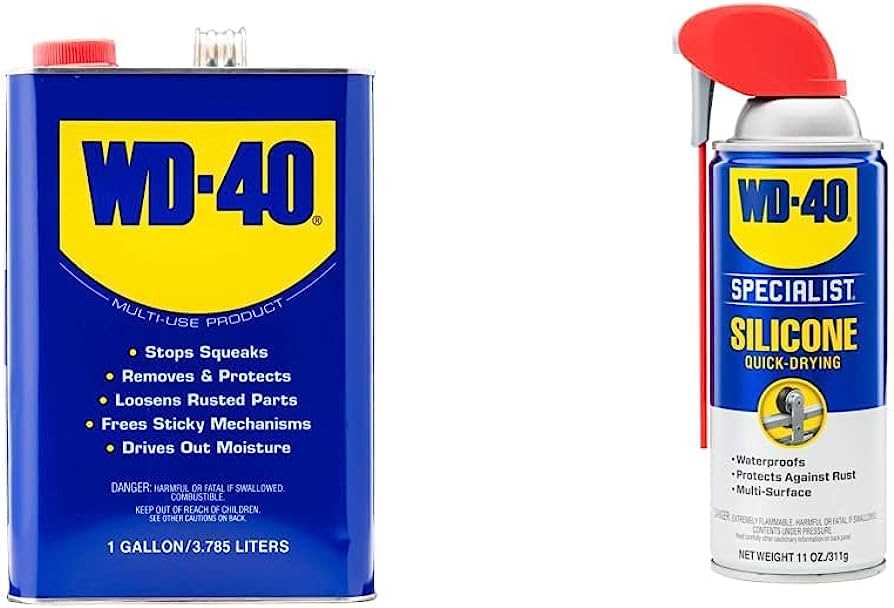
1. WD-40 for Sticky Residue
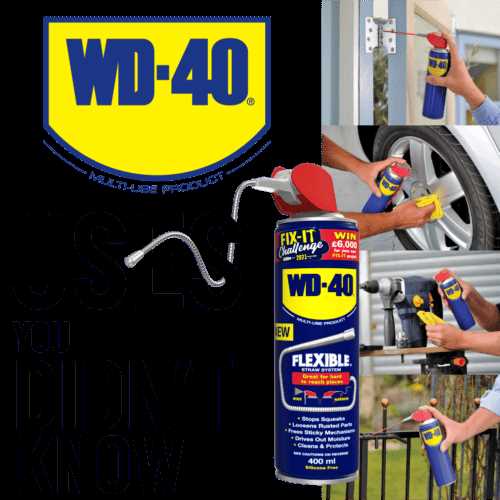
Do you have sticky residue left behind from a sticker or label? WD-40 can help! Simply spray a small amount of WD-40 onto the sticky residue and let it sit for a few minutes. Then, use a cloth or paper towel to wipe away the residue. The lubricating properties of WD-40 will help dissolve the adhesive, making it easy to remove.
2. Removal of Chewing Gum
Chewing gum stuck on clothing or in carpets can be a nightmare to remove. But with WD-40, it’s a breeze! Spray a small amount of WD-40 on the gum and let it sit for a few minutes to loosen the adhesive. Then, gently scrape off the gum with a butter knife or a plastic scraper. Be careful not to damage the surface you’re working on.
3. Removing Tape Residue
Tape can leave sticky residue behind, especially on glass or plastic surfaces. WD-40 is an effective solution for removing tape residue. Spray a small amount of WD-40 onto a cloth or paper towel and rub it over the residue. The residue will dissolve, allowing you to easily wipe it away.
4. Getting Rid of Sticker Residue
Stickers often leave behind stubborn residue when peeled off. To get rid of sticker residue, spray a small amount of WD-40 onto the residue and let it sit for a few minutes. Then, use a cloth or paper towel to wipe away the residue. The adhesive will dissolve, leaving your surface clean and sticker-free.
5. Removing Adhesive from Labels
If you have labels stuck on glass or plastic containers, WD-40 can help you remove the adhesive. Spray a small amount of WD-40 onto the label and let it sit for a few minutes. Then, peel off the label and use a cloth or paper towel to wipe away any remaining adhesive. Your container will be adhesive-free and ready to use.
6. Eliminating Tape Marks on Walls
Tape marks on walls can be unsightly, but WD-40 can help you remove them. Spray a small amount of WD-40 onto a cloth or paper towel and gently rub it over the tape marks. The marks will disappear, leaving your walls clean and mark-free. Be sure to test WD-40 on a small, inconspicuous area of your wall before using it on a larger area.
7. Removing Sticky Residue from Floors

If you have sticky residue on your floors, WD-40 can help you remove it. Spray a small amount of WD-40 onto the residue and let it sit for a few minutes. Then, use a cloth or mop to wipe away the residue. The lubricating properties of WD-40 will dissolve the adhesive, making it easy to clean.
8. Cleaning Adhesive Residue from Furniture
Furniture can often accumulate adhesive residue from stickers or labels. To remove the residue, spray a small amount of WD-40 onto a cloth and gently rub it over the adhesive. The residue will dissolve, allowing you to easily wipe it away. Make sure to test WD-40 on a small, inconspicuous area of your furniture before using it on a larger area.
9. Removing Glue from Surfaces
If you have accidentally spilled glue or have glue residue on a surface, WD-40 can help you remove it. Spray a small amount of WD-40 onto the glue and let it sit for a few minutes. Then, use a cloth or paper towel to wipe away the glue. The lubricating properties of WD-40 will dissolve the glue, making it easy to clean.
10. Getting Rid of Adhesive Residue from Electronics

Adhesive residue can build up on electronics, making them look dirty and unattractive. To remove the residue, spray a small amount of WD-40 onto a cloth and gently rub it over the adhesive. The residue will dissolve, allowing you to easily wipe it away. Make sure to power off and unplug your electronics before cleaning them.
11. Removing Sticker Residue from Clothing
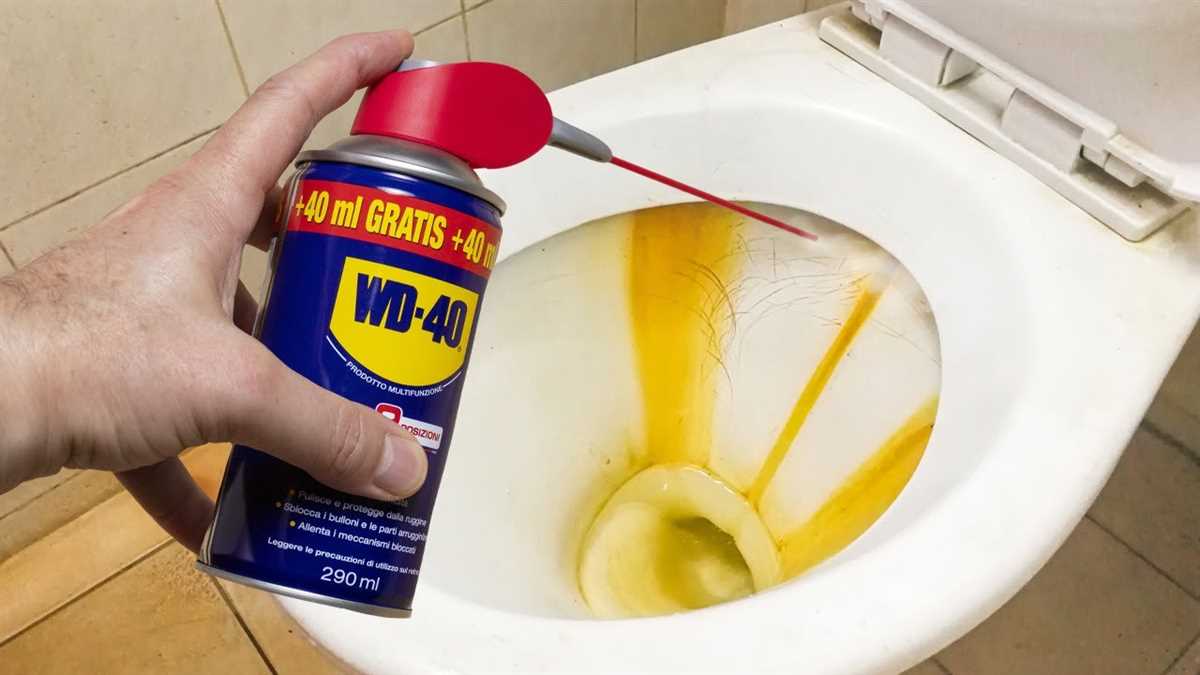
Sticker residue on clothing can be tricky to remove, but WD-40 can help. Spray a small amount of WD-40 onto the residue and let it sit for a few minutes. Then, use a cloth or sponge to gently rub the residue away. Launder the clothing as usual to remove any remaining residue and WD-40.
12. Removing Adhesive from Ceramic Surfaces
Ceramic surfaces, such as tiles or dishes, can accumulate adhesive residue over time. To remove the residue, spray a small amount of WD-40 onto a cloth and gently rub it over the adhesive. The adhesive will dissolve, allowing you to easily wipe it away. Rinse the ceramic surface with water to remove any remaining residue and WD-40.
13. Cleaning Adhesive Residue from Glass
Glass surfaces can often have adhesive residue from stickers or labels. To remove the residue, spray a small amount of WD-40 onto a cloth and gently rub it over the adhesive. The residue will dissolve, allowing you to easily wipe it away. For a streak-free finish, clean the glass surface with glass cleaner after removing the residue.
14. Removing Sticky Residue from Plastic
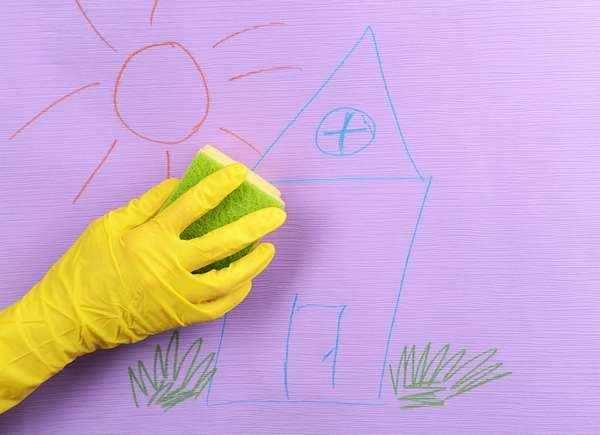
If you have sticky residue on plastic surfaces, WD-40 can help you remove it. Spray a small amount of WD-40 onto the residue and let it sit for a few minutes. Then, use a cloth or sponge to gently rub the residue away. Rinse the plastic surface with water to remove any remaining residue and WD-40.
Conclusion
WD-40 is not just for lubricating squeaky doors or loosening rusted bolts. It can also be a powerful tool for tackling sticky residue and adhesive messes. Whether it’s removing tape marks from walls or getting rid of sticker residue, WD-40 can make your cleaning routine easier and more efficient. Remember to test WD-40 on a small, inconspicuous area of the surface before using it on a larger area.
FAQ
What is WD-40?
WD-40 is a multi-purpose spray product that can be used for a wide range of tasks, including lubricating, cleaning, and protecting various surfaces.
Can WD-40 be used for cleaning?
Yes, WD-40 can be a useful tool for cleaning, as it can help remove stubborn stains, grease, and grime from various surfaces.
What surfaces can WD-40 clean?
WD-40 can clean a variety of surfaces, including metal, plastic, glass, and wood. It is important to test it on a small, inconspicuous area before using it on a larger area to ensure it does not damage the surface.
Can WD-40 remove sticker residue?
Yes, WD-40 can effectively remove sticker residue. Simply spray WD-40 onto the sticky area, let it sit for a few minutes, and then wipe it away with a clean cloth.
Is WD-40 safe to use around children and pets?
WD-40 should be used with caution around children and pets. While it is not considered highly toxic, it is best to keep it out of reach and avoid direct contact or inhalation.
Can WD-40 be used to clean kitchen appliances?
WD-40 can be used to clean kitchen appliances such as stoves, ovens, microwaves, and refrigerators. However, it is important to thoroughly clean and rinse the surfaces after using WD-40 to ensure no residue remains.
Can WD-40 be used to remove rust?
Yes, WD-40 can help remove rust from metal surfaces. Spray WD-40 onto the rusted area, let it sit for a few minutes, and then scrub it with a wire brush or abrasive pad. Repeat as necessary until the rust is removed.












